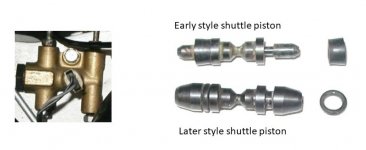First off, picture credits to Buckeye Triumph's Tech Pages.
Please note that if you do not have the PDWA switch connected, all the talk about using the warning light to determine shuttle piston centering is moot. No connection, no light.
With these cars, when the PDWA is in place, bleeding the brakes will shift the piston and it must be recentered.
The center volume of the PDWA should be dry unless one of the PDWA seals is leaking. This means that you can remove the switch without introducing air into the system. If you pull the swicth and see brake fluid, it is leaking and you need to replace the PDWA piston seals.
There were two styles of shuttle pistons used on the TR6 but with yours being a 1970, it should be the later style. The middle portion of the piston is much smaller in diameter than the rest of the piston body. There are ramps on either side of the small diameter center section of the piston. That is where the pin from the switch would sit under normal operating conditions. If pressure is lost in one of the two brake circuits the shuttle piston is shifted which in turn pushes the pin on the switch up as it rides up the ramp. If connected, that will trigger the warning light under normal driving conditions.
If the PDWA shuttle piston is shifted forward, then you need to open a bleeder at the rear. If the PDWA piston is shifted rearward, then you need to open a bleeder on the front. (IIRC)
I have heard of people using an awl or ice pick to manually shift the piston but I have always shifted the piston back to it normal "neutral" position by hydraulic means by having a helper open a bleed valve and slowly pushing the pedal until the piston is centered, then have the helper close the bleed valve. When connected, the piston is centered when both the oil pressure light and the PDWA light glow dimly. If the PDWA light is bright and the oil pressure light doesn't glow, then the piston is not centered. The bleeding and PDWA piston centering is described in section 70.25.02 of the Bentley manual if you have one of those. If not, you should get one, it is essentially a reprint of the factory shop manual.
If the switch is not connected, then you are looking at two helpers. One to crack open the bleed valve and one that knows what they are looking for to be watching the piston as it goes to the centered position.

 Hi Guest!
Hi Guest!

 smilie in place of the real @
smilie in place of the real @
 Pretty Please - add it to our Events forum(s) and add to the calendar! >>
Pretty Please - add it to our Events forum(s) and add to the calendar! >> 


